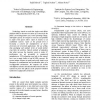446 search results - page 38 / 90 » Modeling and Comparing Spatiotemporal Events |
IJON
2002
13 years 9 months ago
2002
Recent in vivo intracellular measurements indicate that cortical neurons operate in a highconductance state mainly caused by intense network activity. Biophysical models of morpho...
ICPR
2010
IEEE
13 years 10 months ago
2010
IEEE
—Variations in walking speed have a strong impact on the recognition of gait. We propose a method of recognition of gait that is robust against walking-speed variations. It is es...
GIS
2010
ACM
13 years 7 months ago
2010
ACM
Mobile intention recognition is the problem of inferring a mobile user's intentions from her behavior in geographic space. Such behavior is constrained in space and time. Cur...
ICANN
2010
Springer
13 years 11 months ago
2010
Springer
Abstract. We investigate the extent to which eye movements in natural dynamic scenes can be predicted with a simple model of bottom-up saliency, which learns on different visual re...
IPPS
2007
IEEE
14 years 4 months ago
2007
IEEE
Technology trends are such that single event effects (SEE)are likely to become even more of a concern for the future. Decreasing feature sizes, lower operating voltage, and higher...

